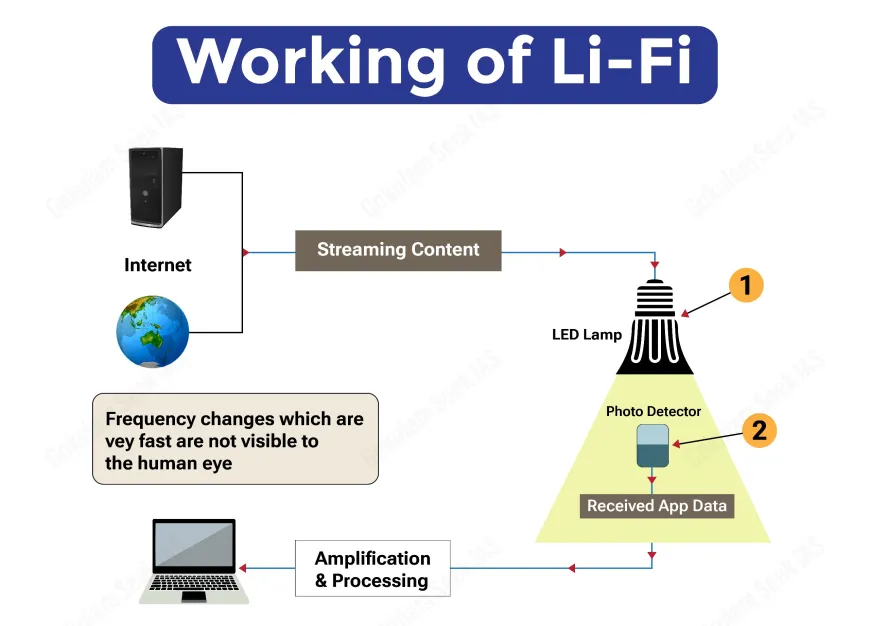With the ever-growing demand for faster, safer, and more efficient wireless communication, Li-Fi (Light Fidelity) has emerged as a revolutionary solution. Unlike traditional Wi-Fi, which uses radio frequency (RF) waves, Li-Fi uses visible light from LED bulbs to transmit data—ushering in a new era of light-based internet.
But how exactly does Li-Fi work? How can simple LED light bulbs power the internet, stream videos, or transfer files? This comprehensive article will walk you through every technical and practical aspect of how Li-Fi works, including its core components, working mechanism, data transmission process, and real-world deployment scenarios.

What is Li-Fi Technology?
Li-Fi (Light Fidelity) is a wireless communication technology that transmits data using light waves emitted by LED bulbs. It is a subset of Visible Light Communication (VLC) and was introduced by Professor Harald Haas in 2011 during a TED Talk titled “Wireless data from every light bulb.”
Basic Principle: Communication Through Light
Li-Fi is based on a simple yet powerful idea: modulating the intensity of light at such high speeds that the human eye cannot detect the changes, but a photo detector (light sensor) can.
This light modulation encodes binary data (1s and 0s), which is then decoded back into readable digital content like web pages, video, or audio by the receiving device.
Key Components of a Li-Fi System
To understand how Li-Fi works, it’s important to know the hardware involved:
1. LED Light Bulb
- Acts as the transmitter.
- Emits modulated light signals representing binary data.
- Can be regular room lights in homes, offices, or street lamps.
2. Photodetector
- A light sensor (usually a photodiode) that captures the light signal.
- Converts light fluctuations into electrical signals.
3. Driver Circuit
- Controls the intensity and switching of the LED.
- Manages the on/off cycles that represent digital bits.
4. Modulation Unit
- Converts raw data into a format suitable for light transmission.
- Often uses On-Off Keying (OOK) or Orthogonal Frequency Division Multiplexing (OFDM).
5. Receiver Circuit
- Interprets the light signals back into original data.
- Sends the decoded data to the internet router or device processor.
Step-by-Step: How Li-Fi Works
Step 1: Data Input
The Li-Fi system receives data from a source (e.g., your router, laptop, or cloud server).
Step 2: Modulation of Light
The input data is sent to a controller that modulates the LED’s intensity—turning it on and off rapidly to create light pulses that represent binary code.
Step 3: Light Transmission
The modulated LED light is emitted into the surrounding space. This light beam carries the encoded data through the visible spectrum or infrared/ultraviolet light.
Step 4: Signal Detection
A photodetector placed on the receiver’s end detects the light signal and records the intensity variations.
Step 5: Demodulation
The variations are converted back into electrical signals and then translated into binary data by the receiver’s decoder.
Step 6: Data Output
The decoded data is delivered to the device—whether that’s a phone, computer, TV, or sensor—just like with Wi-Fi.
Data Modulation in Li-Fi
Light must be modulated to represent binary data (1s and 0s). Here are the most common techniques used:
1. On-Off Keying (OOK)
- Turning the light on = binary “1”
- Turning the light off = binary “0”
2. Pulse Width Modulation (PWM)
- Varies the duration of light pulses.
3. OFDM (Orthogonal Frequency Division Multiplexing)
- Uses multiple carrier frequencies to increase data speed and reduce interference.
Li-Fi Communication Types
There are three main types of Li-Fi communication setups:
1. Point-to-Point (Unidirectional)
- Light travels in one direction only, like from bulb to receiver.
2. Bidirectional
- Data travels both ways using dual light sources and sensors.
3. Full Duplex
- Enables simultaneous sending and receiving using multiple LEDs and photodetectors.

Li-Fi Architecture Explained
Here’s a simplified layout of a full Li-Fi system:
INTERNET → Li-Fi Router → LED Bulb (Modulated Light) → Photodetector → Signal Decoder → Device (PC/Smartphone)
In an enterprise setup, multiple Li-Fi bulbs (also called Li-Fi Access Points) can form a Li-Fi network, just like multiple Wi-Fi routers.
Limitations and Workarounds
| Limitation | Workaround |
|---|---|
| Line-of-sight required | Use mirrors or reflectors |
| Cannot work in sunlight | Use infrared or UV-based Li-Fi |
| Limited coverage area | Install mesh of Li-Fi routers |
| Device compatibility | Integrate Li-Fi chips in smartphones |
Real-Life Examples of Li-Fi in Action
1. Hospitals
- Medical equipment often malfunctions due to RF interference. Li-Fi ensures safe, clean data transmission in operating rooms.
2. Airplanes
- In-flight entertainment and passenger data systems use Li-Fi for seamless, interference-free connectivity.
3. Smart Classrooms
- LED lights provide both lighting and fast internet access for students using tablets or laptops.
4. Factories and Industrial Plants
- In noisy environments, radio communication is unreliable. Li-Fi ensures data transmission without electromagnetic noise.

Conclusion: How Li-Fi Will Change the Way We Connect
Li-Fi is no longer a sci-fi dream—it’s a practical, scalable, and transformative technology that can reshape the future of wireless communication. By using light instead of waves, Li-Fi offers blazing-fast internet, secure connections, and interference-free transmission in places where Wi-Fi fails.
As smartphones, laptops, and infrastructure evolve, expect Li-Fi to move from labs to living rooms, classrooms, and beyond. In the coming years, every LED bulb could become a wireless hotspot, making light itself the carrier of information.


 Watch
Watch
 CASUAL WEAR
CASUAL WEAR




[…] on faster, more secure, and interference-free data communication, a revolutionary innovation called Li-Fi (Light Fidelity) is gaining momentum. While Wi-Fi uses radio waves to transmit data, Li-Fi uses light waves, […]
[…] the global demand for faster, more secure, and interference-free wireless communication grows, Li-Fi (Light Fidelity) has emerged as a groundbreaking solution. Unlike Wi-Fi, which relies on radio frequencies, Li-Fi […]